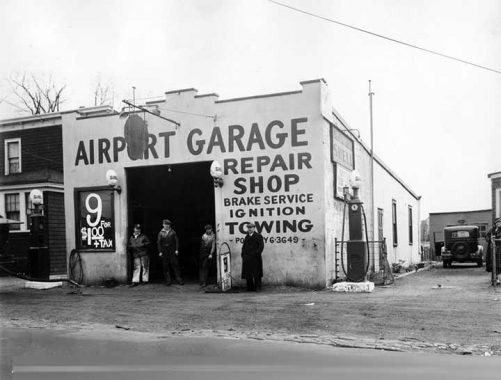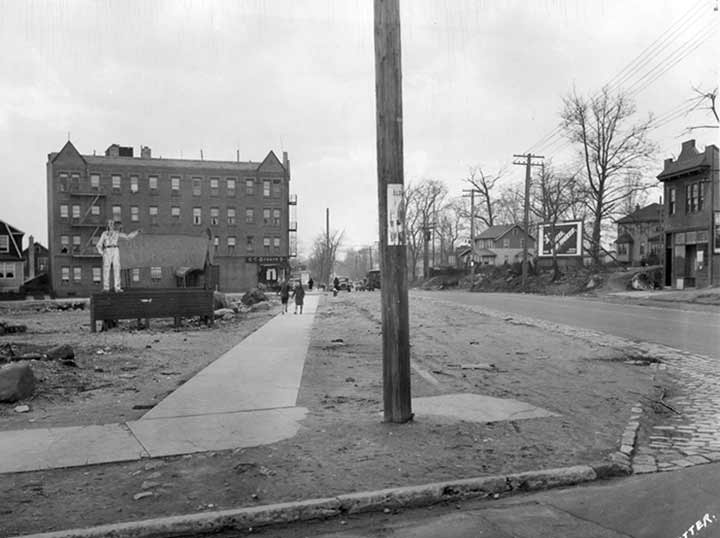
A few years ago, I reached into the archives to feature a photo from 1932 featuring a sign pointing to Glenn Curtiss Airfield, which is now the mighty LaGuardia Airport. I’ll show that here with my notes from that day, as well as a couple new photos never before shown.
LAGUARDIA Airport was constructed in 1929 as Glenn Curtiss Field, and later, North Beach Airport, replacing a former North Beach amusement area called the Gala Amusement Park, opened in 1889 by piano master William Steinway and beer baron George Ehret; it fell flat when Prohibition was enacted in 1920. The North Beach area and park were served by the Brooklyn City Railroad, which operated a trolley line along Old Bowery Bay Road, once one of the only thoroughfares in eastern Jackson Heights and East Elmhurst. The line survived into the 1930s and served the airport for a time. The airport was expanded to a full-service NYC airport beginning in 1939, and is currently undergoing massive renovations that will add new terminals and other amenities.
Glenn Curtiss (1878-1930) was a motorcycle manufacturer who became an early aviation pioneer.
On July 4 [1908], Curtiss piloted the “June Bug” across Pleasant Valley for a distance of 5,090 feet – 1,810 feet farther than required. No less important, it was the first officially-recognized, pre-announced and publicly-observed flight in America. It won Curtiss the first leg of the trophy and established him as America’s foremost aviation pioneer. In 1909, he flew his “Golden Flyer” a distance of 24.7 miles to establish a new world distance record and win the second leg of the Scientific American trophy. Later that same year, in Rheims, France, competing against Europe’s top aviators, he won the Gordon Bennet Cup speed race, averaging 46 mph. In 1910, when the New York World Newspaper offered a $10,000 prize for the first successful flight between Albany and NYC, following the Hudson River, Curtiss again determined to be first, and did so in a craft he had named the “Hudson Flyer”. He won the prize money, nationwide recognition, and in the process, won the third leg of the Scientific American Competition and permanent possession of the coveted trophy. It was his much-publicized Albany to New York flight that established the aeroplane as having some practical value. [Glenn Curtiss Museum]
There’s a lot going on in this 1932 photo looking west at Astoria Boulevard at 94th Street. At left, a billboard points the way to Glenn Curtiss Airport. In 2020, 94th Street remains an important approach point to LGA from the south and was also part of the route the streetcar line took to get to North Beach.
The apartment building with the peaked cornices at 93rd Street remains in place, as well as the private home yo the right of the billboard across Astoria Boulevard.
At the time, Astoria Boulevard was still a modest two-lane highway. Change is in the offing, however. You can see that ground has been cleared to the right of the telephone pole in the foreground. this was part of Astoria Boulevard’s expansion into a 6-lane behemoth, 8 if you count the parking lanes, all part of the construction of the Grand Central Parkway through Queens in the 1930s. West of 80th Street, Astoria Boulevard serves as the GCP’s service lanes. In the 1930s, transportation was quickly moving away from the old horse and buggy days to fossil fuel powered automotive and flying vehicles. Environmental ramifications for all this are under discussion in the 2020s.
The photo was snapped by Edgar E. Rutter (1883-1964), official Brooklyn photographer who also exposed photos all over NYC; I look to Rutter as well as Eugene Armbruster and Percy L. Sperr as inspirations for my own work.

Nearby was this pizzeria (spelled incorrectly on one of the signs) that served travelers en route, or coming back, from Curtiss Airport. Note that the Coca-Cola script logo has remained essentially unchanged since 1932.

The Airport Garage was also nearby. Note the single gas pump in the alley. What would “9 for $1.00 & tax” indicate? Comments are open.
The Grand Central Parkway, built along Astoria Boulevard in the 1930s under direction of NYC traffic czar Robert Moses, would obliterate the pizzeria and garage.
As always, “comment…as you see fit.” I earn a small payment when you click on any ad on the site.
7/29/23


18 comments
I saw Glenn Curtiss’s V-8 powered motorcycle in a museum.It was a funky looking
thang that looked like it was built around the time of the Civil War by a stagecoach
builder rather than in the early 1900s
Chris: As I mentioned in a previous FNY posting, I too made the pilgrimage to the Glenn Curtis Museum in Hammondsport, NY in 2002. The museum is interesting & visiting the town was like time travel. I can still recall stopping at a luncheonette near the museum; it had a pressed tin ceiling, a soda fountain & a comfort food menu. It’s well worth making the trip (I hope it hasn’t changed too much since then).
In “downtown” Hammondsport, you could stand in the middle of the street all day and not get hit by a car.
9 for 1 I think it means 9 gallons of gas for $1.
Curtiss’ prize winning feat in the “Hudson Flyer” concluded on the grounds of the Isham mansion, now Isham Park at the northern end of Manhattan. Cole Thompson’s site Myinwood.net gives quite al lot of coverage.
https://myinwood.net/?s=glenn+curtiss
“9 for $1.00 & tax” is not gasoline, because in the early 1930s the retail price per gallon was 19 or 20 cents. Can;t figure this one out.
“Andy”, on the contrary, I’d wager it does refer to gallons of gasoline as my Dad’ spoke of “specials” that appeared at certain filling stations in his early years of driving (beginning ca. 1931). One deal was “8 gallons for a buck.” Of course, these were perhaps infrequent spasms, the products of price wars, but they were a reality and a welcome boon, even if not commonplace to Depression-era drivers.
The letters on that Glenn Curtiss sign are impossible to read. Even then, they didn’t make it easy! I imagine the “9 for $1+tax” refers to 9 gallons of gas @ 11 cents + tax per gallon, which sounds about right for the time. Meanwhile, trying to figure out that long phone exchange that starts with a “P” and ends with “Y.”
The telephone exchange was POmeroy 6.
9 gallons for $1 11cents a gallon!!
My guess is that it was nine quarts of motor oil for a dollar. Cars back then burned a lot of oil and the price is about right.
The small sign to the right of the garage door has the same deal as the window. I straightened the sign out in Photoshop. It seems to read 9 EG for $1.00 Plus Tax. EG may be an Ethanol Gallon. Ethanol was used in the 20s and 30s due to gas shortages and may have cost less.
William Steinway, of the piano family, was the father of North Beach. He had the idea of an amusement park that would cater to families that worked for his firm and others. And that it was until Steinway died in the mid-1890’s. Then North Beach slid downhill. Alcohol was served on illegally Sunday’s, gambling dens became popular, and loose women started to ply their trade in the area.
My great aunt told me that she and her friends wanted to go there as teenagers, but her father refused permission stating that she might be mistaken for a prostitute.
94th and Astoria Blvd. was such an important intersection on the route to LGA it had three diners.
My great-grandaunt, Sarah Belle Easton, met her future husband, an older man by the name of George W. Knight, in around 1890 when she worked at a hotel in North Beach. She and her brother, George J. Easton, lived in Corona. George became a LIRR engineman on the Whitestone Branch and lived in Whitestone landing, where my future grandmother met my future grandfather. The Eastons were half-English, half-German American. German Americans fought for the sale of beer on Sundays as it was part of their social rituals. People worked on Saturdays then and Sunday was the only day to socialize. Noise complaints arose from the boisterousness of the trolley passengers and people wanted less, so fought for the laws against Sunday alcohol sales.
Not sure where Alan was standing but always cars, and motorcycles coming through town
BTW King Kong was killed by Curtiss airplanes
“The airplanes didn’t kill him, it was beauty killed the beast”.
There is actually a 2nd gas pump at this early Shell station (to the left of the 9 for $1 window).